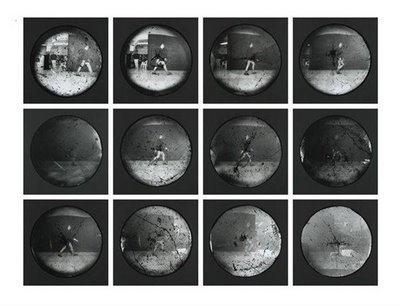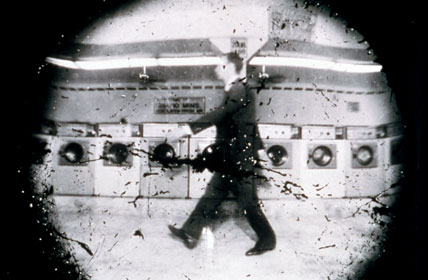

Essay by Giorgia Bottinelli
June 2002
Steven Pippin first experimented with
temporarily transforming washing machines into cameras in 1989 after he had
noticed a number of similarities in the workings of washing machines and the
development of photographs.
For him 'the elaborate and precise mechanism of the washing machine was a
perfect system for making photographs. The eye of the machine (with the
addition of an aluminium hood combining lens and shutter device) adapted to the
transition of camera lens with the slightest of intervention. The pre-wash,
rinse, main wash and final rinse cycles adapted to the chemical process of
developer, rinse, fixer and final wash all of which were accurately temperature
controlled.' (Steven Pippin, 'Pictorial Troubleshooting', in Discovering the
Secrets of..., p.56.)
London-based Pippin made his first Laundromat
images in 1991. In 1997, using a row of twelve commercial washing machines in a
laundromat based in Bayonne, New Jersey, he made a number of more ambitious
series titled Laundromat-Locomotion. The title of these series refers to
the analysis of human and animal motion undertaken by pioneering photographer
Eadweard Muybridge (1830-1904). Published as Animal Locomotion in 1887,
Muybridge's study examined movement through sequential images using a number of
cameras furnished with mechanically tripped shutters. There is a direct
relationship between Muybridge's work and Laundromat-Locomotion. Pippin
has written that the more he thought about Muybridge 'the more it seemed
necessary to pay some kind of tribute' and added that the excessive scratching
caused by the negatives being spun at 500 rpm in a washing machine unexpectedly
gave his images 'some degree of authenticity by making it look like an original
Muybridge from one hundred years ago. The scratches on the negative surface
becoming a substitute for time, an artificial ageing process lending the
pictures an accidental air of authenticity.' (Steven Pippin, 'Applied
Photography', in Laundromat - Locomotion, pp.153, 154.)
Pippin's Laundromat-Locomotion
series of 1997 mark the ambitious culmination of his washing machines project
and Laundromat-Locomotion (Walking in Suit) is especially remarkable for
the range of clarity to abstraction
as the sequence progresses. It was produced in an edition
of five (of which this is number one) and consists of twelve black and white
contact prints made from paper
negatives which were fixed to the back of the washing machines' drums, opposite
the opening. Having previously set up twelve cotton tripwires in front of the
adapted washing machines, the artist triggered the shutters sequentially by
walking across the tripwires. The photographs portray him in profile, wearing a
suit. Pippin often wears a suit while working and in this case he purposefully
wore one both to install his apparatus and in the photographs as an 'ordinary'
counterpoint to his eccentric activities, in order to blend in with the
laundromat's customers.
The suit worn by Pippin and clothing
in general are a critical element of this work. Indeed, as the artist has
stated, the idea of 'the physical mass of clothing inside the machine being
replaced by the more ephemeral image of the clothes, projected inside by the
action of light reflected from a suited figure walking past the outside, was
the primary concept or meaning of the work, and is crucial to any understanding
of it.' ('Applied Photography', p.157.)
Further reading:
Laundromat - Locomotion: Mr. Pippin, San Francisco Museum of Modern Art
1998, reproduced pp.18-9
Discovering the Secrets of... Monsieur Pippin,
exhibition catalogue, Fonds Régional d'Art Contemporain Limousin, Limoges 1995

Just wasting some time on Stumbleupon and I found your entry. Not normally what I prefer to learn about, but it was definitely worth my time. Thanks.
Thanks a million for this, I am greatful for the info
@chels I know what you mean, its hard to find good help these days. People now days just don't have the work ethic they used to have. I mean consider whoever wrote this post, they must have been working hard to write that good and it took a good bit of their time I am sure. I work with people who couldn't write like this if they tried, and getting them to try is hard enough as it is.
Just wasting some in between class time on Stumbleupon and I found your entry. Not typically what I like to learn about, but it was certainly worth my time. Thanks.
Thank you for the advice. I’ve found your first point to be most effective.